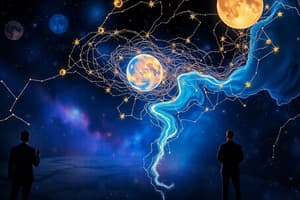Podcast
Questions and Answers
What are two important questions when considering dream interpretation?
What are two important questions when considering dream interpretation?
How do theoretical assumptions influence dream interpretation? What are the roles of the dreamer and the interpreter?
Which of the following is NOT a method of dream interpretation?
Which of the following is NOT a method of dream interpretation?
- Cultural
- Associative
- Phenomenological
- Diagnostic (correct)
What is Freud's view of the mind represented as?
What is Freud's view of the mind represented as?
An iceberg
What are the three conflicting components of the mind according to Freud?
What are the three conflicting components of the mind according to Freud?
What principle governs the Id?
What principle governs the Id?
What principle does the Ego operate under?
What principle does the Ego operate under?
What are the two components of the Superego?
What are the two components of the Superego?
If the Id is too dominant in an adult, what characteristic might they exhibit?
If the Id is too dominant in an adult, what characteristic might they exhibit?
Freud believed that dreams always have both manifest and latent content.
Freud believed that dreams always have both manifest and latent content.
Match the following terms with their descriptions:
Match the following terms with their descriptions:
What does Carl Jung believe about dreams?
What does Carl Jung believe about dreams?
Flashcards are hidden until you start studying
Study Notes
Dream Theories and Interpretation
- Dream interpretation relies on various theoretical assumptions, influencing how dreams are understood.
- Cultural beliefs significantly shape the meanings and components of dreams.
- Psychotheoretical methods necessitate a trained analyst for interpretation.
- Associative interpretation involves personal connections and emotions linked to dream content.
- Emotion focusing entails understanding dreams by concentrating on intense feelings experienced.
- Personal projection allows others to help identify meanings in one’s dreams.
- The phenomenological approach emphasizes re-experiencing dreams to relate them to real life.
Freud's Perspective
- Freud conceptualizes the mind as an iceberg, illustrating conscious and unconscious elements.
Three Components of the Mind
- The mind consists of three conflicting components: the Id, the Ego, and the Superego.
- Healthy psychological functioning requires balance among these elements to prevent neurosis or psychosis.
The Id
- The Id represents primal instincts and immediate desires, operating on the Pleasure Principle.
- It is emotional and demanding, focusing solely on self-gratification without consideration for others.
The Ego
- The Ego acts rationally and pragmatically, governed by the Reality Principle.
- It mediates between the desires of the Id and external realities, developing strategies for deferred gratification.
The Superego
- The Superego embodies moral standards, reflecting societal and parental values.
- It consists of the Ego ideal (standards of good behavior) and Conscience (standards of bad behavior).
Psychodynamic Theory Applications
- Dominance of the Id can result in self-absorption and indifference.
- An overly dominant Ego may lead to cold detachment and lack of emotion.
- Superego dominance may cause feelings of guilt and moral superiority.
Interpretation of Dreams
- Dreams possess both manifest content (surface-level, bizarre narratives) and latent content (true, hidden meanings).
- Free Association is a technique used to uncover unconscious thoughts through dream symbols.
Dreamwork Processes
- Displacement: substitute symbols represent hidden desires.
- Projection: the dreamer attributes personal feelings to external characters.
- Symbolization: repressed urges manifest metaphorically in dreams.
- Condensation: complex feelings are condensed into simple dream images.
- Rationalization: the dreaming mind restructures incoherent elements into logical narratives.
Examples of Dream Symbolism
- A dream involving a cactus may symbolize feelings of being invaded or experiencing overcrowding.
Carl Jung's Interpretation
- Jung views dreams as a direct communication channel to the unconscious, aiding in personal insights and problem-solving.
- Meaning is subjective, and personal interpretation holds greater importance than external opinions.
- Contextualizing the dream is crucial before interpreting its significance.
Studying That Suits You
Use AI to generate personalized quizzes and flashcards to suit your learning preferences.




